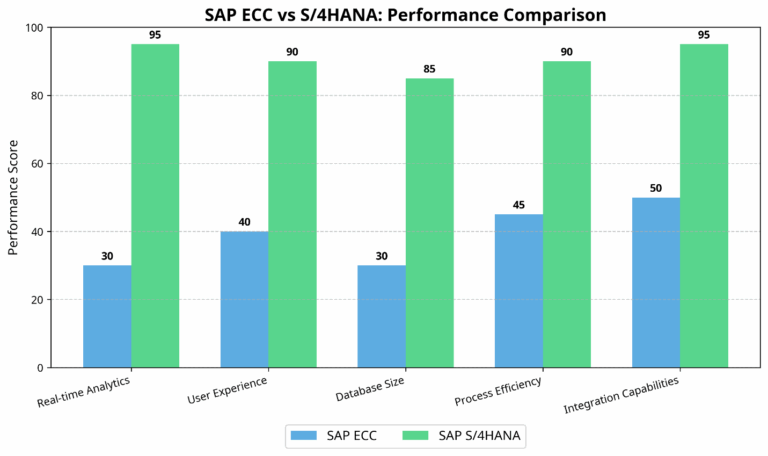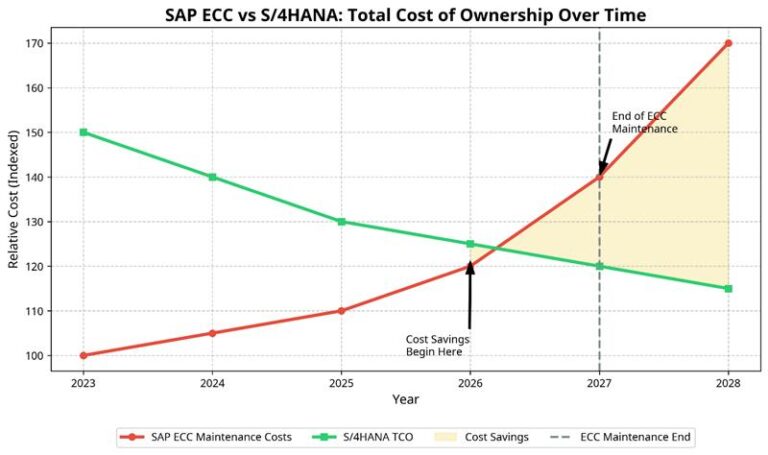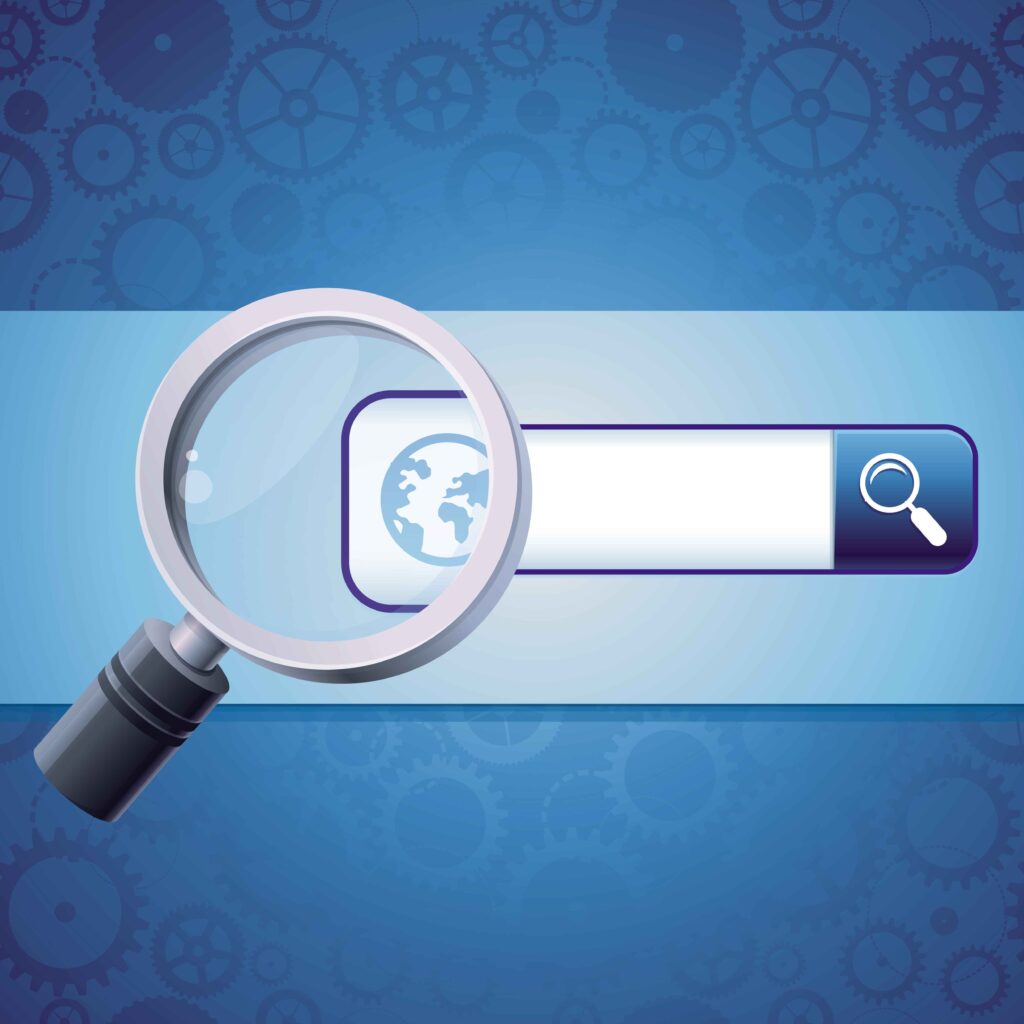At its core, S/4HANA leverages the SAP HANA in-memory database for high-speed data processing, removing legacy database dependencies and reducing IT complexity. The system employs artificial intelligence to detect patterns, optimize operations and processes, and analyze live data for faster, more informed decision-making. This combination of in-memory computing, simplified data models, and intelligent automation creates an ERP platform that is fundamentally more capable of meeting contemporary business challenges.
Key Differences Between SAP ECC and S/4HANA
The transition from SAP ECC to S/4HANA represents more than a typical software upgrade—it constitutes a fundamental transformation in how enterprise systems operate. Understanding these differences is crucial for organizations planning their migration strategy.
Database Architecture
The foremost difference between S/4HANA and ECC lies in their database architecture. While SAP ECC supports multiple databases like DB2, Oracle, and SQL Server, SAP S/4HANA runs exclusively on the HANA memory database. This architectural distinction has profound implications for performance, as HANA’s in-memory processing eliminates the need for separate operational and analytical systems, enabling real-time reporting and analytics directly on transactional data.
The columnar storage approach of HANA dramatically reduces the database footprint compared to traditional row-based storage used in ECC. Data compression and the elimination of redundant tables like MATDOC and ACDOCA decrease storage consumption and simplify the data model, making it more intuitive and easier to maintain.
Deployment Flexibility
SAP ECC is primarily limited to on-premises deployment, reflecting its development during an era when cloud computing was in its infancy. In contrast, S/4HANA offers multiple deployment options: on-premises, on a hosted cloud, on a public cloud, or in a hybrid environment that combines both on-premises and cloud components. This flexibility allows organizations to select the deployment model that best aligns with their IT strategy, security requirements, and operational needs.
User Experience
The user experience difference between the two systems is striking. SAP ECC relies on the traditional SAP GUI with a limited number of Fiori apps, presenting a functional but dated interface that often requires extensive training for new users. S/4HANA, by contrast, employs SAP Fiori 3.0 as its default interface, delivering a consumer-grade user experience with responsive design, role-based access, and intuitive navigation.
This enhanced user interface significantly improves adoption rates and productivity, as users can access the system from any device with a consistent experience. The simplified screens and personalized dashboards reduce training requirements and enable users to focus on their core tasks rather than navigating complex system interfaces.
Data Processing and Analytics
Perhaps the most transformative difference lies in how the two systems process data. SAP ECC follows the traditional batch processing method, where data is processed in scheduled intervals, creating inevitable delays between transaction execution and reporting availability. S/4HANA, leveraging its in-memory architecture, enables real-time analytics and reporting on live transactional data.
This capability fundamentally changes how businesses can operate, enabling instant visibility into operations, immediate financial closing processes, and real-time decision support. The elimination of data latency allows organizations to respond more quickly to market changes, customer needs, and operational challenges.

Business Benefits of Migrating to SAP S/4HANA
The business case for migrating to S/4HANA extends far beyond technical improvements, offering tangible benefits that directly impact an organization’s competitive positioning and financial performance.
Improved Operational Efficiency
Real-time reporting and the automation of repetitive tasks accelerate business processes, reducing manual work and operational delays. Organizations implementing S/4HANA typically report significant improvements in process efficiency, with some achieving up to 50% faster month-end closing processes and dramatic reductions in report generation time from hours to seconds.
The simplified data model and elimination of redundant tables also streamline operations, reducing the complexity of data management and the resources required to maintain system performance. This efficiency extends across all business functions, from finance and procurement to manufacturing and supply chain management.
Enhanced Customer Satisfaction
In today’s customer-centric business environment, the ability to respond quickly and accurately to customer needs represents a critical competitive advantage. S/4HANA enables organizations to achieve better service delivery and greater customer satisfaction through real-time order processing, predictive analytics for anticipating customer needs, and faster response times.
The system’s advanced available-to-promise functionality provides more accurate delivery date commitments, while its integrated customer data model offers a comprehensive view of customer interactions across all touchpoints. These capabilities collectively enhance the customer experience, driving loyalty and retention in increasingly competitive markets.
Superior Integration Capabilities
Organizations can integrate SAP solutions such as SAP CRM, SAP SuccessFactors, SAP Ariba, SAP Fiori, SAP Cloud, and SAP IBP using S/4HANA’s unified data model. This integration provides enhanced data sharing and collaboration across previously siloed functions, creating a truly connected enterprise where information flows seamlessly between departments and processes.
The integration extends beyond SAP products to third-party applications and data sources, enabling a comprehensive digital ecosystem that adapts to changing business requirements. This flexibility is particularly valuable in today’s dynamic business environment, where the ability to quickly incorporate new capabilities can determine market leadership.
Cost Optimization
SAP cloud and hybrid deployments significantly lower infrastructure and IT maintenance costs, reducing the total cost of ownership (TCO) compared to traditional on-premises ERP implementations. The simplified data model and reduced storage requirements further contribute to cost savings, while the automation of routine tasks decreases labor costs and frees resources for more strategic initiatives.
Many organizations report substantial cost reductions after migrating to S/4HANA, with savings in infrastructure, maintenance, and operational expenses often offsetting a significant portion of the migration investment. These cost benefits compound over time as the organization leverages S/4HANA’s capabilities to drive further operational efficiencies.
Accelerated Decision-Making
Perhaps the most strategically significant benefit of S/4HANA is its impact on decision-making speed and quality. Businesses can make informed decisions faster through real-time analytics, predictive analysis, and comprehensive reporting capabilities. The system’s ability to process vast amounts of data in real-time enables more accurate forecasting, scenario planning, and risk assessment.
This accelerated decision-making capability translates directly to competitive advantage, allowing organizations to respond more quickly to market opportunities, customer needs, and competitive threats. In industries where timing can determine success or failure, this advantage alone can justify the investment in S/4HANA migration.
Technical Advantages of S/4HANA
Beyond the business benefits, S/4HANA offers substantial technical advantages that transform how enterprise systems operate and support business processes.
Real-Time Data Processing
The in-memory architecture of HANA enables instant data analysis without the delays associated with traditional database systems. By eliminating batch processing, S/4HANA reduces data lag, improving the accuracy of reports and forecasts and enabling real-time operational visibility.
This capability is particularly valuable for data-intensive processes such as financial closing, inventory management, and supply chain optimization, where timely information directly impacts operational performance and financial outcomes.
Simplified Data Model
S/4HANA introduces a dramatically simplified data model that eliminates redundant tables and aggregates, reducing database size by up to 90% compared to traditional ERP systems. This simplification not only improves performance but also makes the system easier to maintain, customize, and extend.
The streamlined data architecture also facilitates more intuitive reporting and analytics, as users can directly access transactional data without navigating complex table relationships or waiting for aggregation processes to complete.
Advanced Analytics and AI Integration
S/4HANA leverages artificial intelligence and machine learning to enhance business processes, from predictive maintenance and inventory optimization to automated financial reconciliation and fraud detection. These capabilities enable organizations to move from reactive to proactive management approaches, anticipating issues before they impact operations.
The system’s embedded analytics provide role-based insights directly within transactional screens, eliminating the need to switch between operational and analytical systems. This integration of analytics into daily workflows democratizes data access and empowers users at all levels to make data-driven decisions.
Enhanced Security and Compliance
In an era of increasing regulatory requirements and cybersecurity threats, S/4HANA offers significant advantages in security and compliance management. The system provides built-in security features to prevent unauthorized data access and automated monitoring for compliance with regulatory requirements such as SOX and GDPR.
End-to-end encryption protects sensitive business data, while the simplified data model makes it easier to implement and maintain security controls. These capabilities help organizations reduce compliance costs and mitigate security risks in an increasingly complex regulatory environment.

The Migration Journey: Planning for Success
The transition from SAP ECC to S/4HANA represents a significant undertaking that requires careful planning, preparation, and execution. Understanding the key steps and considerations in this journey is essential for minimizing disruption and maximizing the value of the investment.
Assessment and Planning
A successful migration begins with a thorough assessment of the current data landscape, identifying custom developments, dependencies, and legacy data that will need to be addressed during the transition. This assessment should include a comprehensive inventory of existing SAP and non-SAP systems, interfaces, and custom code.
Organizations must also evaluate their business processes against S/4HANA best practices to identify opportunities for standardization and optimization. This process often reveals inefficiencies and redundancies that can be eliminated during the migration, delivering additional value beyond the technical upgrade.
Data Preparation
Data quality and volume management represent critical success factors in S/4HANA migration. Organizations should clean up data by archiving, deleting, or standardizing information before migration to reduce complexity and improve system performance.
This preparation phase often includes data archiving projects to reduce the volume of historical data that needs to be migrated, as well as data cleansing initiatives to address inconsistencies and duplications. Investing in these activities before migration can significantly reduce project complexity and risk.
Migration Approach Selection
- Organizations must choose between several migration approaches based on their specific requirements and constraints:
- Greenfield Implementation: A complete reimplementation that starts fresh with S/4HANA, allowing for comprehensive process redesign but requiring more extensive data migration and potentially longer implementation timelines.
- Brownfield Conversion: An in-place conversion of the existing SAP ECC system to S/4HANA, preserving customizations and historical data but potentially carrying forward inefficiencies from the legacy system.
Hybrid Approach: Combines elements of both approaches, selectively reimplementing some components while converting others, offering a balance between innovation and continuity.
Each approach has distinct advantages and challenges, and the selection should align with the organization’s strategic objectives, resource constraints, and risk tolerance.
Change Management and Training
The transition to S/4HANA introduces significant changes to user interfaces, business processes, and data structures. A comprehensive change management and training program is essential for ensuring user adoption and realizing the full benefits of the new system.
Organizations should develop role-based training materials that focus on the specific changes relevant to each user group, emphasizing the benefits and productivity improvements that S/4HANA enables. Early involvement of key users and business process owners can help build internal champions who facilitate broader adoption.
How TekLeaders Can Help with AI, GenAI and ECC to HANA Migration: Real-time Scenarios with Measurable ROI
With our expert team who has vast experience in AI, GenAI, and HANA migration, TekLeaders stands at the forefront of SAP transformation. As organizations navigate the complex journey from SAP ECC to S/4HANA, partnering with TekLeaders can significantly reduce risk and accelerate value realization. Our specialized expertise goes beyond the technical migration process to leverage cutting-edge AI and Generative AI capabilities, maximizing the return on your S/4HANA investment. Let’s explore some real-world scenarios where TekLeaders has delivered exceptional value with measurable ROI.
Manufacturing Process Optimization with AI
Client Challenge: A global automotive parts manufacturer was struggling with production inefficiencies, high inventory costs, and quality control issues while planning their migration from SAP ECC to S/4HANA.
- TekLeaders Solution: TekLeaders implemented a dual-track approach:
- Migration Track: TekLeaders conducted a comprehensive assessment of the client’s SAP landscape, identifying over 200 custom developments and 15 critical interfaces that required special attention. Using a hybrid migration approach, TekLeaders preserved valuable customizations while reimplementing inefficient processes.
AI Enhancement Track: In parallel with the migration, TekLeaders deployed an AI-powered predictive maintenance solution that integrated with the client’s IoT sensors on manufacturing equipment. This solution analyzed real-time data from production lines and predicted potential failures before they occurred.
- Measurable ROI (May 2025):
- 37% reduction in unplanned downtime, translating to $5.2M in saved production costs annually
- 22% decrease in maintenance costs, saving $3.1M per year
- 98.7% equipment availability (up from 91.2%), increasing production capacity by 7.5%
- 18% reduction in spare parts inventory, freeing up $4.3M in working capital
- Total first-year ROI: 342% on the AI investment component
Migration cost recovery through AI-driven efficiencies: 24 months vs. industry average of 40 months
The client’s CIO stated: “TekLeaders didn’t just migrate us to S/4HANA; they transformed our entire approach to manufacturing. The AI-powered predictive maintenance solution has paid for itself within six months, and the real-time visibility we now have across our operations has enabled us to make decisions in minutes that previously took days.”
Supply Chain Resilience with GenAI
Client Challenge: A multinational consumer goods company faced supply chain disruptions during the pandemic and wanted to build greater resilience while modernizing their SAP landscape.
- TekLeaders Solution: TekLeaders implemented:
- S/4HANA Migration: Using a carefully planned brownfield approach, TekLeaders migrated the client’s complex global SAP ECC system to S/4HANA with minimal business disruption.
GenAI-Powered Supply Chain Intelligence: TekLeaders developed a custom GenAI solution that continuously monitors global news, weather patterns, social media, and supplier data to identify potential supply chain disruptions before they impact operations.
The GenAI system uses natural language processing to analyze thousands of data sources daily, creating risk scores for different supply chain nodes and automatically suggesting mitigation strategies. When disruptions are detected, the system generates detailed impact assessments and recommends alternative sourcing options, transportation routes, or production adjustments.
- Measurable ROI (May 2025):
- 45% reduction in supply chain disruption impacts, preventing an estimated $12.7M in lost sales
- 28% improvement in forecast accuracy, reducing excess inventory by $8.3M
- 3-week average early warning for potential disruptions, providing critical time for mitigation
- $4.2M in avoided costs during a major port strike through early rerouting
- 19% reduction in expedited shipping costs, saving $2.9M annually
- Total first-year ROI: 278% on the GenAI investment
Combined S/4HANA and GenAI implementation payback period: 18 months
The Supply Chain Director commented: “The GenAI solution TekLeaders built has transformed how we manage risk. During a recent natural disaster affecting our key suppliers in Asia, the system identified the potential impact three weeks before our competitors, allowing us to secure alternative sources and maintain production while others faced stockouts. The ROI has far exceeded our expectations.”
Financial Operations Transformation with AI and GenAI
Client Challenge: A global financial services firm was struggling with manual financial processes, compliance reporting burdens, and limited visibility into financial performance while planning their S/4HANA migration.
- TekLeaders Solution: TekLeaders delivered:
- Accelerated S/4HANA Implementation: Using TekLeaders’ Financial Services Industry Template, the team completed a greenfield S/4HANA implementation in just 9 months, 40% faster than industry average.
- AI-Powered Financial Operations: TekLeaders implemented machine learning models for:
- Automated account reconciliation with 99.7% accuracy
- Anomaly detection for fraud prevention
- Predictive cash flow forecasting
- Intelligent matching of payments to invoices
- GenAI for Regulatory Compliance: TekLeaders developed a GenAI solution that:
- Continuously monitors regulatory changes across global jurisdictions
- Automatically updates compliance reporting templates
- Generates regulatory documentation with proper audit trails
Provides natural language interfaces for compliance inquiries
- Measurable ROI (May 2025):
- 78% reduction in manual journal entries, saving 12,500 person-hours annually ($1.9M)
- 5-day reduction in month-end close process (from 7 days to 2), improving financial decision-making speed
- 92% straight-through processing for accounts payable, reducing processing costs by $2.3M annually
- 99.8% compliance accuracy with zero regulatory penalties, avoiding $4.5M in potential fines
- $3.7M annual savings in finance operations costs through headcount reallocation to strategic activities
- 31% improvement in working capital management through better cash forecasting, freeing up $18.2M
- Total first-year ROI: 412% on the AI/GenAI components
Complete project ROI (including S/4HANA implementation): 187% over three years
The CFO noted: “TekLeaders’ implementation of AI and GenAI capabilities alongside our S/4HANA migration has transformed our finance function from a cost center to a strategic asset. Our finance team now spends 70% of their time on analysis and strategic support rather than transaction processing and compliance reporting. The measurable ROI has made this one of our most successful technology investments ever.”
Customer Experience Enhancement with GenAI
Client Challenge: A retail chain with over 500 locations was experiencing declining customer satisfaction and struggling to compete with digital-native competitors while running an outdated SAP ECC system.
- TekLeaders Solution: TekLeaders implemented:
- S/4HANA Cloud Migration: TekLeaders migrated the client from on-premises SAP ECC to S/4HANA Cloud, enabling greater agility and reducing IT infrastructure costs.
- Omnichannel Integration: TekLeaders built seamless connections between S/4HANA and the client’s e-commerce platform, mobile app, and in-store systems.
- GenAI-Powered Customer Experience: TekLeaders developed:
- A conversational AI shopping assistant that understands complex product inquiries
- Personalized product recommendations based on individual customer preferences
- Automated content generation for product descriptions and marketing materials
Visual search capabilities allowing customers to find products by uploading images
The GenAI solution leverages S/4HANA’s real-time inventory and customer data to provide accurate, personalized responses across all customer touchpoints.
- Measurable ROI (May 2025):
- 32% increase in customer satisfaction scores, leading to 24% improvement in retention
- 28% growth in online conversion rates, generating $14.3M in additional annual revenue
- 17% increase in average order value, adding $8.7M to annual sales
- 41% reduction in customer service call volume, saving $3.2M annually
- 22% improvement in inventory turnover, reducing carrying costs by $5.1M
- 68% reduction in IT infrastructure costs through cloud migration, saving $4.8M annually
- Total first-year ROI: 247% on the combined implementation
Customer lifetime value increase: 31%, representing $42.5M in long-term value
The Chief Digital Officer shared: “TekLeaders has helped us leapfrog our competition. The GenAI capabilities they’ve implemented don’t just automate customer interactions—they create genuinely helpful, personalized experiences that have transformed how customers perceive our brand. And because everything is integrated with S/4HANA, we have complete visibility across all channels. The ROI metrics speak for themselves—this has been transformational for our business.”
Intelligent Document Processing for Manufacturing
Client Challenge: A manufacturing company was drowning in paperwork during their S/4HANA migration planning, with thousands of technical documents, specifications, and quality control records that needed to be processed and integrated.
- TekLeaders Solution: TekLeaders implemented:
- Phased S/4HANA Migration: TekLeaders designed a phased migration approach that prioritized critical business processes while minimizing disruption.
- GenAI Document Intelligence: TekLeaders developed a custom GenAI solution that:
- Automatically extracts information from technical documents, regardless of format
- Classifies and categorizes documents based on content
- Identifies relationships between documents and materials/products
- Generates structured data for S/4HANA from unstructured documents
Creates searchable knowledge bases with natural language query capabilities
- Measurable ROI (May 2025):
- 94% reduction in manual document processing, saving 18,700 person-hours annually ($2.8M)
- 87% faster retrieval of technical information, reducing engineering time waste by $3.4M annually
- 100% digitization of paper-based processes, eliminating $1.2M in physical storage costs
- 65% improvement in engineering change management efficiency, accelerating time-to-market by 37%
- $2.1M annual savings in document management costs
- 29% reduction in quality issues due to better information access, saving $4.7M in rework and warranty costs
- Total first-year ROI: 325% on the GenAI document solution
Combined S/4HANA and GenAI implementation ROI: 176% over three years
The Head of Engineering noted: “What impressed me most about TekLeaders was their understanding of both our technical documentation needs and how to integrate that with S/4HANA. The GenAI solution they built doesn’t just digitize our documents—it makes the knowledge within them actionable. Our engineers can now find the exact information they need in seconds rather than hours. The ROI has been exceptional, with productivity gains far exceeding our projections.”
Getting Started with TekLeaders: The Assessment Process
For organizations considering their SAP ECC to S/4HANA migration journey, TekLeaders offers a comprehensive assessment service that evaluates your existing SAP landscape, business processes, and strategic goals to develop a tailored roadmap for your transformation journey.
- The assessment process includes:
- Current State Analysis:
- SAP system landscape documentation
- Custom code and modification inventory
- Interface and integration mapping
- Data volume and quality assessment
- Business process efficiency evaluation
- Future State Design:
- S/4HANA deployment model recommendation (on-premises, cloud, hybrid)
- Migration approach selection (greenfield, brownfield, hybrid)
- AI and GenAI opportunity identification with ROI projections
- Business process optimization recommendations
- Integration strategy development
- Transformation Roadmap:
- Phased implementation plan
- Resource requirements and timeline
- Risk mitigation strategies
- Business case development with detailed ROI analysis
Change management and training approach
This assessment typically takes 4-6 weeks and delivers a detailed migration strategy, including timeline, resource requirements, risk mitigation approaches, and expected business benefits. The assessment also identifies specific opportunities for AI and GenAI integration, ensuring that your S/4HANA implementation delivers maximum value from day one.
- ROI of the Assessment Process:
- Average identified cost savings: 27-35% compared to traditional migration approaches
- Average identified revenue enhancement opportunities: $3.2M-$7.5M annually through AI/GenAI
- Typical risk reduction: 42% fewer migration issues compared to non-assessed projects
- Implementation timeline reduction: 3-6 months faster completion on average
Assessment investment payback: Typically within the first 2-3 months of implementation
A recent client who completed the assessment process in April 2025 commented: “TekLeaders’ assessment was eye-opening. They identified AI and GenAI opportunities we hadn’t considered that could generate an additional $4.2M in annual value beyond the standard S/4HANA benefits. Their roadmap gave us complete confidence in our migration strategy, and the projected ROI made it easy to secure executive approval for the full project.”
As the 2027 deadline approaches, organizations that partner with experienced consultants like TekLeaders will be best positioned to not only complete their migrations successfully but also to leverage the full potential of S/4HANA’s capabilities. By combining deep SAP expertise with cutting-edge AI and GenAI knowledge, TekLeaders helps organizations transform their ERP systems from operational necessities into strategic assets that drive competitive advantage in the digital age—with measurable ROI that consistently exceeds industry benchmarks.
The 2027 Deadline: Why Act Now
With SAP’s announcement that mainstream maintenance for SAP ECC will end in 2027, organizations face a definitive timeline for migration. This deadline creates both urgency and opportunity for SAP customers.
Latest Update (May 2025)
According to SAP’s most recent announcements, organizations that have not begun their migration planning by the end of 2025 will face significant challenges in securing qualified implementation resources. Current market analysis shows that demand for SAP S/4HANA migration expertise is projected to exceed supply by 35% in 2026, potentially leading to increased costs and extended timelines for late adopters.
Risk Mitigation
- Continuing to operate on SAP ECC beyond the maintenance deadline exposes organizations to significant risks, including:
- Security vulnerabilities that will no longer receive patches or updates
- Compliance issues as regulatory requirements evolve without corresponding system updates
- Support challenges as SAP and partner resources increasingly focus on S/4HANA
Competitive disadvantages as peers leverage S/4HANA capabilities for business innovation
These risks increase over time, making early migration planning a prudent risk management strategy.
Resource Availability
As the 2027 deadline approaches, demand for SAP S/4HANA implementation resources—both internal and external—will intensify. Organizations that begin their migration journey earlier will benefit from greater availability of experienced consultants, more favorable pricing, and less time pressure.
This early-mover advantage extends to internal resources as well, allowing for more gradual knowledge transfer and skill development without the compressed timelines that later migrations will face.
Value Realization Timeline
Perhaps most importantly, delaying migration postpones the realization of S/4HANA’s substantial business benefits. Organizations that migrate earlier will gain competitive advantages through improved operational efficiency, enhanced decision-making capabilities, and greater agility in responding to market changes.
The cumulative value of these benefits over time can far exceed the costs of migration, making earlier implementation financially advantageous despite the investment required.
Conclusion: Embracing the Future of Enterprise Computing
Cloud-Native Architecture is a modern way of creating applications that are easy to scale, reliable, and secure, all while running in the cloud. By following best practices, leveraging microservices, Containerization, automation, continuous monitoring and cost optimization, businesses can stay competitive and adapt to changing market demands
Why Choose Tek Leaders for Cloud Services?
The transition from SAP ECC to S/4HANA represents more than a technical upgrade—it embodies a fundamental shift in how enterprise systems support and enable business strategy in the digital age. By combining real-time insights, AI-based decision-making, and automation with a simplified data model and intuitive user experience, S/4HANA creates the foundation for the intelligent enterprise.
Organizations that approach this transition strategically, with careful planning and a focus on business value, can transform what might seem like a mandatory technical migration into a catalyst for broader digital transformation. The capabilities that S/4HANA enables—from real-time analytics and process automation to enhanced customer experiences and new business models—align perfectly with the demands of today’s dynamic business environment.
As the 2027 maintenance deadline approaches, the question for SAP customers is no longer whether to migrate to S/4HANA, but how to do so in a way that maximizes value while minimizing disruption. By starting the journey now, with a clear understanding of the benefits, challenges, and best practices, organizations can position themselves for success not just in the migration project itself, but in the digital future that lies beyond.
The path from SAP ECC to S/4HANA may be complex, but the destination—a more agile, intelligent, and competitive enterprise—makes the journey worthwhile. The time to begin that journey is now, and with partners like TekLeaders who bring deep expertise in both SAP and advanced AI technologies, organizations can navigate this transformation with confidence and unlock the full potential of their digital investments.
- References:
- SAP. (2025, May). Official SAP S/4HANA Migration Guide – 2025 Edition. Retrieved from SAP Support Portal.
- Gartner. (2025, April). Market Guide for SAP S/4HANA Service Providers. Gartner Research.
Forrester Research. (2025, February). The Total Economic Impact™ Of SAP S/4HANA. Forrester Research, Inc.




